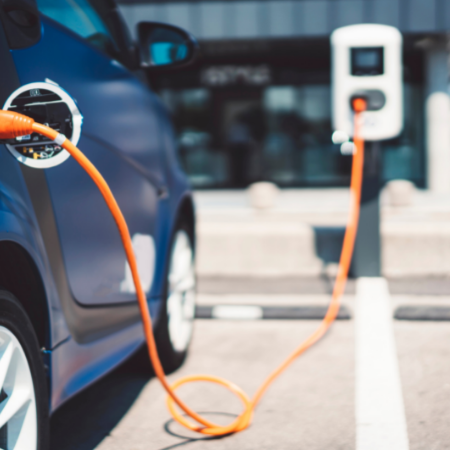Just over one hundred years after the internal combustion engine began to revolutionize transportation in the United States, the automobile industry is undergoing an evolution to a cleaner, more electric future. Electric vehicle sales are surging and auto manufacturers like General Motors have pledged to phase out internal combustion engines and focus production on electric vehicles. With more EVs on our streets and highways, there is an increased demand for charging infrastructure so they can fuel up on electrons. Recognizing the need to develop a modern and decarbonized transportation sector, the White House’s American Jobs Plan includes funding for grant and incentive programs aimed to help state and local governments, as well as the private sector, build 500,000 electric vehicle chargers by 2030. ACEEE found in its review of state transportation electrification policies that some states are also increasingly investing in charging infrastructure, including equitable access to charging, and many state utility commissions are enlisting the utilities they regulate in the process. Cities are key stakeholders in the siting and installation of local EV charging networks, and they can help ensure the buildout is done in an intelligent and equitable manner.

A new white paper from the American Council for an Energy-Efficient Economy (ACEEE) brings into focus the importance of Siting Electric Vehicle Supply Equipment (EVSE) with Equity in Mind. This paper examines the role of utilities and their actions to date in equitable EVSE siting, which is a crucial component in equitable transportation electrification.
NLC’s Nick Kasza held a virtual discussion with ACEEE’s Peter Huether about the white paper and the takeaways for city leaders regarding electric vehicle charging infrastructure siting. Some of the responses have been edited for clarity.
Nick Kasza: Before we dive into the report findings, can you provide some background on EV charging infrastructure. What is electric vehicle supply equipment and where is it found within a city?
Peter Huether: Electric vehicle supply equipment (EVSE) encompasses all the infrastructure required to charge a plug-in vehicle from the electricity grid’s distribution wires to the meter to the charger itself. The charger that a driver sees is only the end of this chain, which all need upgrading to support widespread transportation electrification. Public chargers are generally either Level 2 (L2) or fast charging (DCFC) with the former charging a vehicle in 6-8 hours while DCFC can charge a vehicle 80 percent in 30 minutes or less. DCFC is common along heavily trafficked routes such as interstates, downtown cores, and busy shopping centers but is significantly more expensive to install compared to L2, which is more common in residential, workplace, and some commercial parking facilities. DCFC can also support charging for those who cannot do so at home because they do not have access to consistent and charging-enabled off-street parking, including many apartment dwellers and renters more generally.
Low- and moderate-income (LMI) drivers have lower access to charging-enabled off-street parking, so expanding public charging where they live is crucial for equity. Equitable charging can also include charging for transit buses, which are disproportionately used by low-income Americans, and charging for large commercial vehicles, which disproportionately contribute to air pollution that harms low-income communities and communities of color.
Nick: That’s very helpful background information. Let’s turn to the report, what were the key takeaways?
Peter: Overall, there has been progress in some states but most states and utilities are not doing enough to ensure that electric vehicle charging infrastructure investments are reaching all communities. Utilities nationwide have pledged $2.4 billion in EVSE investment, with $646 million specifically earmarked for LMI communities and communities of color. However, the vast majority of the investment has been in just two states, California and New York. Additionally, at the time of our research, only six states required their investor-owned utilities to include considerations for LMI communities or communities of color in their investments or plans. We also emphasize the importance of looking beyond just charging for personal vehicles, including for buses and trucks, and the importance of good and early community engagement by utilities. To create equitable EV programs, utilities will need to undertake comprehensive community engagement to identify community-specific opportunities and gaps for transportation electrification. The best community engagement centers community needs throughout the planning and investment process and in doing so, builds long-term trust.
Nick: How can these takeaways translate to what cities can do to help ensure equitable EVSE siting?
Peter: Cities have a key role to play to ensure equitable EVSE siting given their close relationship to their communities, jurisdiction over siting and land use decisions, and authority over transit. Through their own community engagement, cities are likely to have a better sense of where EV investments may be most useful for underserved communities or may have insights from their own equitable transportation planning processes about key passenger and freight mobility needs. Cities also often have some authority over transit and transit agencies, which need to cooperate closely with utilities when electrifying their bus fleets. Cities can facilitate this cooperation as they can also facilitate the siting of EVSE throughout their communities with easier zoning, permitting, and departmental coordination. In particular, cities have control over their right of ways, including on-street parking spots, and can also decide whether areas are allowed to have chargers installed. Cities can also update their building codes to ensure that a portion of parking in new apartment buildings can be easily outfitted with chargers in the future. Given that apartment buildings disproportionately house low-income families, ensuring they can serve their charging needs is a core equity issue.
Nick: How can city leaders facilitate meaningful community engagement, particularly with underserved communities that might be overlooked for EVSE siting?
Peter: Cities can be partners with utilities in the latter’s community engagement efforts to ensure the engagement is meaningful and informs investment decisions. This can involve sharing best practices that the city has learned over time, providing public facilities for meetings, and connecting utilities with relevant community organizations. Cities should also stress to utilities that they provide support, including financial compensation and translation services, to community members to ensure that there is broad participation in the community engagement process. It is important that overburdened communities are listened to and their needs are included in EVSE siting plans as much as possible to ensure the EVSE has the biggest impact possible and that these communities benefit.
Nick: Do you have any good city examples?
Peter: Our white paper highlights the example of Seattle City Light, the municipally owned utility primarily serving Seattle, Washington, and its ongoing efforts to engage with communities as part of its broader transportation electrification plans. City Light partnered with the city’s Department of Neighborhoods during the engagement process and met with more than 50 stakeholder groups, including 25 environmental justice community leaders. City Light also relied on the City of Seattle’s Equity and Environment Agenda, which identified communities to prioritize engagement and investment. This process then led to the utility prioritizing investments in EVSE serving apartment dwellers, the electrification of city buses, ride-hailing vehicles, and commercial fleets in environmental justice communities. The utility also made sure to meet with organizations when it was convenient for them, solicited input on how they wanted to be involved, budgeted for childcare, food, and interpretations services, and empowered community voices in decision-making. These are all principles that can work for cities as much as they can work for utilities. For more information on city efforts to encourage EV adoption, see ACEEE’s City Clean Energy Scorecard report.
Siting Electric Vehicle Supply Equipment (EVSE) with Equity in Mind is authored by Peter Huether from the American Council for an Energy-Efficient Economy.









